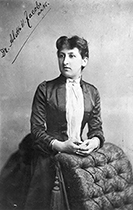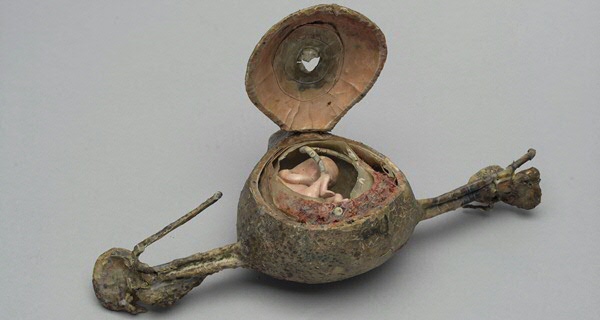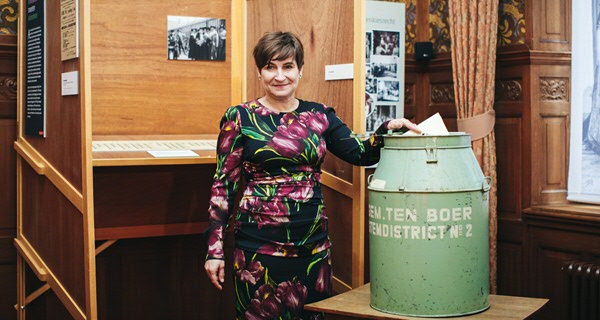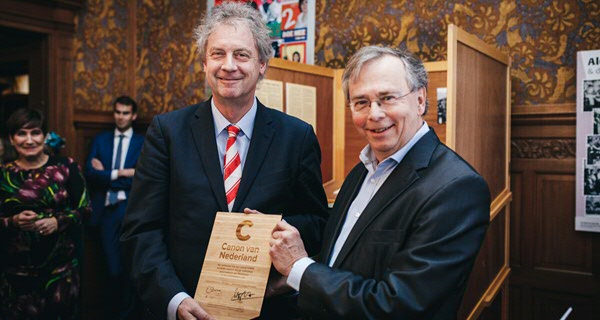Consultation room of dr. Aletta Jacobs
With the official opening of the refurbished Aletta Jacobs room in 2018 by Lilianne Ploumen, the University Museum Groningen is presenting three iconic objects from Dutch history. These were specially selected for the ‘Canon of Dutch History’ and give a unique insight into the history of women’s emancipation.
In presenting these pieces, the University Museum Groningen officially enters the national Canon Network. Willem Bijleveld, director of the Netherlands Open Air Museum, presented Prof. Elmer Sterken, the then President of the University of Groningen, with the Canon Shield that symbolizes membership of the network.

Aletta Jacobs can rightly be called a power woman. Not only was she the first female in the Netherlands to graduate from university, she also defended prostitutes, introduced the cervical cap in the Netherlands, fought for women’s voting rights and travelled all over the world to promote world peace.
This consulting room contains many of her personal belongings. In the corner you can see the suitcase she took with her on the journeys all the way to China and South Africa. Her watch is also on display, as are her tea cosy and rusk tin.
Ever since childhood, she knew she wanted to be a doctor. ‘From my sixth birthday on, I insisted with the utmost certainty that I was going to be a doctor. Not for a second the thought entered my mind, that this might be hard for a girl. At home boys and girls were alike in every way,’ she wrote later.
Her path proved to be a difficult one. To enrol at the university, she had to take the entrance exam. But without a proper preparatory education, she was never going to pass.
So Aletta studied to become an apprentice pharmacist. She passed the exam when she was sixteen. Then she heard that a boy who had the same diploma she did, had been given dispensation by special permission by minister Thorbecke. Aletta didn’t hesitate, but wrote to Thorbecke to ask for the same clemency. On the 28th of April 1871, when Aletta was seventeen years old, she was allowed to enrol at the University of Groningen on trial. One year later, on his deathbed, Thorbecke arranged for her definite admission.
Aletta still had a tough road ahead. She and her family were ridiculed and made fun of. One of her brothers even said she was dead to him, because of the harassment. In 1878 however, she passed her medical exam. Her doctor’s degree followed a year later.
It was the start of a life marked by the battle for women’s rights. She won her greatest victory when women got the right to vote in 1919.
Highlights of the Canon of Dutch History
The Canon comprises 50 ‘windows’ through which you see people, events and objects that together tell the history of the Netherlands. Aletta Jacobs is one of these windows. Three iconic objects from Dutch history are presented in the Aletta Jacobs room in the University Museum, because they give a unique insight into the history of women’s emancipation. They bring you closer to the life of Aletta Jacobs and the zeitgeist of her time.
The objects comprise a trunk belonging to Aletta Jacobs, a womb model by the Auzoux firm and Aletta Jacobs’ desk.
The trunk tells the story of Aletta Jacobs’ major world trips in 1911 and 1912. She travelled around the world with the American Carrie Chapman Catt, the first chair of the International Woman Suffrage Alliance, to give shape to the global fight for female emancipation. The trunk accompanied her on these trips. It contains the hats, gowns and jewellery that she wore when speaking to groups or meeting important people. Her initials are still just about visible.
The womb model by the Auzoux firm embodies the modernization of medicine in the 19th century, when observational learning was introduced. The model from 1844 was still in use when Aletta Jacobs began studying medicine in Groningen. During her studies she discovered how doctors treated women, how little women knew about their bodies and above all how little control they had over their own bodies. The womb model thus symbolizes knowledge of and control over the female body.
Aletta Jacobs must have used her desk for her extensive writing. She had a huge network. In her work as a GP she sat at her desk to write letters and prescriptions for her patients. She probably also sat at her desk during many consultations with female patients. She may have sat here in 1898 to write her book De vrouw. Haar bouw en haar inwendige organen, which aimed to teach women more about their own bodies.
Aletta Year: 20 April 2021 – 20 April 2022
The UG will use the Aletta Year to highlight the theme of ‘women in academia’. The University community will be honouring Aletta Jacobs with a year-long programme filled with jointly organized activities to draw continuing attention to the role of diversity in academia. Exactly 150 years after Aletta Jacobs was the first woman in the Netherlands to register at a university as a regular student, on 20 April 2021, the UG, UMCG, Aletta Jacobs School of Public Health, University Museum and Studium Generale will jointly kick off the Aletta Year in honour of Aletta Jacobs.






